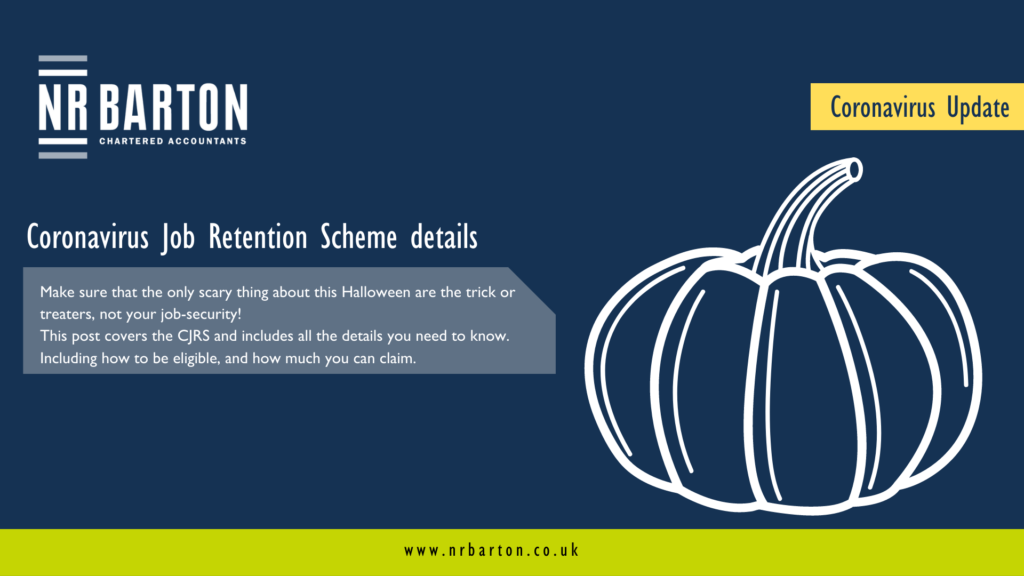Make sure the only thing scary about this Halloween are the trick or treaters!
This Halloween, 31st October 2020, the Coronavirus Job Retention Scheme will come to an end. We summarise what we know so far about the Job Support Scheme which takes its place from the 1st November.

The new scheme will run for six months and for the first 3 months employees must work at least 33% of their usual hours to qualify – this is expected to be reviewed and possibly increased during the latter 3 months of the scheme.
To be able to access the scheme the employer must pay their staff for all the hours worked. The cost of the remaining unworked hours will be divided three ways. The employer will pay one third of the unworked hours with the Job Support scheme contributing another third. Currently, the guidance makes no provision for the final third however, further detailed guidance may make reference to optional employer top ups but for now the member of staff is expected to bear this cost.
Example:
- Sarah usually works 5 days a week and earns £400
- She is put on the support scheme by her employer, working 2 days per week (40% of her usual hours)
- Her employer pays her £160 for the days she works (£400*40%)
- For the days she doesn’t work (3 days, worth £240) Sarah earns £160 – 2/3 of her unworked hours (2/3 of £240 = £160)
- Sarah earns £320 in total – 80% of her usual wages (£160 + £160 = £320)
- The employer will pay 1/3 of her unworked hours at £80 plus the hours she has worked at £160 at a total cost to the employer of £240 – equivalent to 60% of her usual wages
- The government will give a grant for 1/3 of her unworked hours at £80 – equivalent to 20% of her usual wages
The contribution made by the government is capped at £697.92 per month and will not cover the cost of employer’s national insurance or pension contributions as they did at the start of the furlough scheme. The maximum amount that the government can contribute is 22% of the employee’s usual wages (up to £697.92), shown in the table below.
| Hours Employee Worked | 33% | 40% | 50% | 60% | 70% |
| Hours Employee Not Working | 67% | 60% | 50% | 40% | 30% |
| Employee Earnings (% of normal) | 78% | 80% | 83% | 87% | 90% |
| Gov’t Grant (% of normal wages) | 22% | 20% | 17% | 13% | 10% |
| Employer Cost (% normal wages) | 55% | 60% | 67% | 73% | 80% |
It’s also important to be aware that employee’s cannot be made redundant or put on redundancy notice whilst a grant is being claimed for their wages.
The Scheme is open to all small and medium sized businesses in the UK, including those that did not use the CJRS, as long as any employees taking advantage of the scheme were on an Full Payment Submission submitted to HMRC on or before 23rd September 2020. Larger businesses will be subject to a financial test based on turnover.
Those employers that used the CJRS will still be eligible for the £1,000 Job Retention Bonus if they use the Job Support Scheme to keep people in their employment. The Job Retention Bonus is a one-off payment of £1,000 that can be claimed for each employee who was furloughed as part of the CJRS and then continuously employed to 31st January 2021.
Claims under the new Job Support Scheme are to be made monthly, in arrears after the employees have been paid and the RTI has been submitted to HMRC. The claims portal is due to open in December by which time we expect to have further, more detailed guidance on the scheme. For now, the government’s fact sheet can be found using the link:
The ‘winter support package’ places greater responsibility on the employer to fund their employee’s wages but if you’re unsure how the new scheme might affect your business and employees, NR Barton are here to help.




